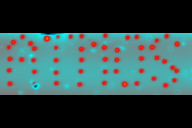IET manipulation
An electric current can induce inelastic effects in a system where vibrations can be excited. In STM, electrons that tunnel through adsorbates at the surface can induce molecular vibrations, occupy electronic orbitals, or both (vibronic excitation). The inelastic tunneling electrons transfer energy into adsorbate vibrations, which results in core vibrations necessary for chemical reactions at the surface.
Using low-energy electrons at a low bias voltage allows for a high lateral resolution of this process, which is commonly used on metallic samples. The use of higher bias voltages leads to a temporary occupation of molecular orbitals and is rather used for semiconducting samples
As the electron energy reaches the threshold energy of the vibrational excitation, molecular vibrations can be induced. The internal energy distribution in the molecule is thereby vastly disturbed, leading to a significant increase of reaction probability after further excitation steps.
Controlled manipulation of single atoms and small molecules using the scanning tunnelling microscope

This article reviews manipulation of single molecules by
scanning tunnelling microscopes, in particular vertical manip-
ulation, lateral manipulation, and inelastic electron tunnelling
(IET) manipulation.

